지령 200호 특집① Ⅱ. [Global Water Issue] 최신 정수기술 다섯 가지
글로벌 수처리기업, 첨단 정수기술 개발 경쟁
알파라발·코흐멤브레인 등, 나노물질로 만든 멤브레인 개발 중
미 NASA, 음향 나노튜브 기술…파나소닉, 광촉매 활용 수처리
아쿠아포린, 생체모방 멤브레인 설계…R2O 등, 자동 가변형 여과
최신 정수기술 다섯 가지
Latest water purification technologies - Top five
급속한 산업화, 인구 증가 등으로 환경문제는 날로 증가해 심각한 사회문제의 하나로 떠올랐으며, 그 중에서도 수질문제는 인체 건강과 가장 밀접하게 닿아 있는 환경문제이다. 환경오염이 심화되면서 상수원수 수질은 점점 나빠지는 반면, 양질의 먹는물에 대한 사람들의 요구는 증가하고 있다. 이에 따라 전 세계 대부분의 국가가 정책적으로 먹는물 수질기준을 강화하는 추세이며, 효율적이고 비용효과적인 정수기술에 대한 수요는 나날이 확대되고 있다. 이에 발맞춰 글로벌 수처리제품 제조업체들은 고객에게 더 나은 서비스를 제공하기 위해 탄소 나노튜브, 고급 멤브레인 시스템과 같은 최첨단 정수기술 개발에 한창이다. 지난 2월 5일자 『Water Technology』에 실린 ‘Latest water purification technologies - top five’ 기사에 △나노기술(Nanotechnology) △음향 나노튜브 기술(Acoustic nanotube technology) △광촉매 정수기술(Photocatalytic water purification technology) △아쿠아포린 인사이드 기술(Aquaporin Inside™ technology) △자동 가변 여과 기술(Automatic Variable Filtration technology) 등 기존의 정수공정 효율을 뛰어넘는 최신 정수기술 다섯 가지가 소개되었다. 그 내용을 번역했다.
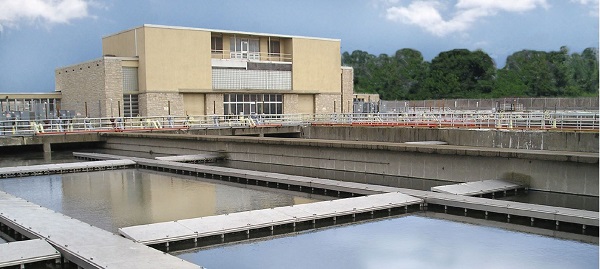
나노기술
Nanotechnology
나노기술(Nanotechnology)은 원자나 분자 크기의 물질을 기초로 하는 다양한 접근 방식과 공정을 포함하는 기술로, 나노기술 기반의 정수 공정은 모듈식(규격화된 부품을 조립하여 만들 수 있는) 구성으로 기존의 정수 방법보다 효율적이고 비용 면에서도 효과적이다. 수처리 공정에서 나노기술이 주로 응용되는 분야는 은, 구리, 영가철(zero-valent iron, ZVI) 나노입자, 나노 구조의 광촉매(nanostructured photocatalysts), 나노 멤브레인(nano-membrane), 나노 흡착제(nanoadsorbent) 등이다.
나노입자의 큰 표면적 대비 부피 비율은 화학적·생물학적 입자의 흡착을 향상시키는 동시에 매우 낮은 농도에서 오염물질을 분리할 수 있다. 나노 흡착제는 물에서 금속 오염 물질을 제거하기 위한 특정한 물리적·화학적 특성을 갖고 있다. 탄소 나노튜브(Carbon nanotubes, CNT)는 정수에 사용되는 탁월한 나노물질 중 하나로 간주된다. CNT를 기반으로 한 여과 시스템은 물에서 유·무기 화합물뿐만 아니라 생물학적 화합물까지 제거할 수 있다.
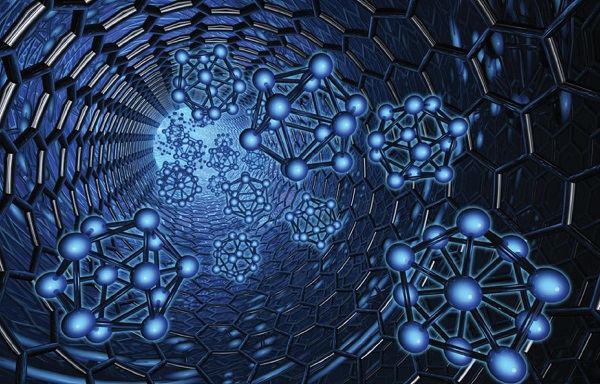
현재 알파라발(Alfa Laval), 어플라이드 멤브레인(Applied Membranes), 다우듀폰(DowDuPont), GEA그룹, 이노포르(Inopor), 코흐 멤브레인 시스템(Koch Membrane Systems)과 같은 글로벌 기업이 처리 중 오염물질 제거를 위해 나노물질로 구성된 멤브레인 개발에 참여하고 있다.
Nanotechnology involves several approaches and processes of applying materials on the atomic or molecular scale. Nanotech-based water purification processes are considered to be modular, highly efficient and cost-effective when compared to conventional water purification methods. The major applications of nanotechnology in water treatment processes include silver, copper and zero-valent iron(ZVI) nanoparticles, nanostructured photocatalysts, nano-membranes, and nanoadsorbents.
The large surface-to-volume ratio of nanoparticles enhances the adsorption of chemical and biological particles, while enabling the separation of contaminants at very low concentrations. Nanoadsorbents feature specific physical and chemical properties for the removal of metallic pollutants from water. Carbon nanotubes(CNTs) are considered to be one of the prominent nanomaterials used in water purification. CNT-based filtration systems can remove organic, inorganic and biological compounds from water.
Global companies such as Alfa Laval, Applied Membranes, DowDuPont, GEA Group, Inopor, and Koch Membrane Systems are involved in the development of membranes that are made of nanomaterials to eliminate pollutants during the treatment.
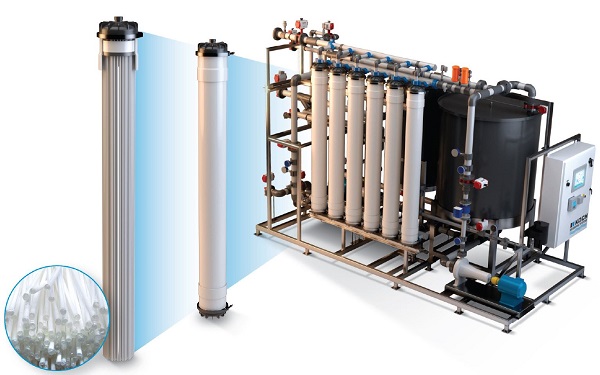
음향 나노튜브 기술
Acoustic nanotube technology
음향 나노튜브 기술(Acoustic nanotube technology)은 미 항공우주국(NASA, 나사)의 존슨우주센터(Johnson Space Center) 과학자들이 개발한 기술이다. 작은 직경의 탄소 나노튜브를 통해 물을 전달하기 위해 압력 대신 음향을 이용한다는 것이 특징이다.
이 기술은 더 큰 분자와 오염물질을 차단하면서 물 분자가 통과하도록 도와주는 탄소 나노튜브와 통합된 음향 구동 분자 스크린을 기반으로 한다. 물에서 오염물질을 제거하는 대신 오염물질에서 물을 제거하기 때문에 기존 여과 시스템보다 전력 소모가 적으며, 필터 시스템을 세척(flushing)할 필요도 없다.
음향 나노튜브 기술의 주요 적용 분야는 지자체 정수처리시설, 의료시설, 실험실(laboratories), 증류소(distilleries), 담수화 시설(desalination plants), 산업시설, 하·폐수처리장 등이다. 사용자의 다양한 수처리 요구에 따라 여러 필터와 통합될 수 있어 호환성이 뛰어나다. 나사(NASA)가 특허 보유한 이 음향 나노튜브 기술은 기업이 라이선스를 취득하고 상용화된 정수 제품으로 발전시키는 데 도움을 줄 수 있다.

The acoustic nanotube technology was invented by scientists at Nasa’s Johnson Space Center. It employs acoustics in place of pressure to direct water through small-diameter carbon nanotubes.
The technology is based on an acoustically driven molecular screen integrated with carbon nanotubes that allow the passage of water molecules while blocking any larger molecules and contaminants. It consumes less power than traditional filtration systems and drives water away from contaminants instead of removing pollutants from water. The process also eliminates the need for flushing the filter system.
The primary applications of acoustic nanotube technology are municipal water plants, medical facilities, laboratories, distilleries, desalination plants, industrial facilities, wastewater treatment plants, and consumer segment. The innovation is scalable with the integration of multiple filters, according to the filtration needs of users. Nasa’s patented acoustic nanotube technology is available for the firms to license and evolve into a commercial water purification product offering.
광촉매 정수기술
Photocatalytic water purification technology
광촉매(photocatalysis)를 이용한 수처리 기술은 효율성이 뛰어나 최근 몇 년간 주목받고 있다. 이 기술은 광촉매와 자외선(UV)을 사용해 물에서 독성물질을 제거한다. 파나소닉(Panasonic)은 광촉매(TiO2, 이산화티타늄)를 상업적 흡착제와 제올라이트(zeolite)라고 하는 촉매에 결합시키는 기술을 개발, 물에서 광촉매를 효과적으로 분리해 재이용수를 회수하고 있다. 광촉매의 일종인 이산화티타늄은 물질을 분리하기 위해 햇빛이나 인공 빛에서 나오는 자외선을 사용한다.
광촉매는 아산화질소와 같은 무기화합물뿐만 아니라 다양한 종류의 유기물질, 에스트로겐, 살충제, 염료, 원유 및 미생물(바이러스, 내염소성 병원체 등)을 분해할 수 있다. 광촉매 수처리 시스템은 상하수도 처리시설에서 사용하기에 적합하며, 고부하 유기물질 또는 금속 등으로 오염된 산업폐수를 처리할 수 있다.
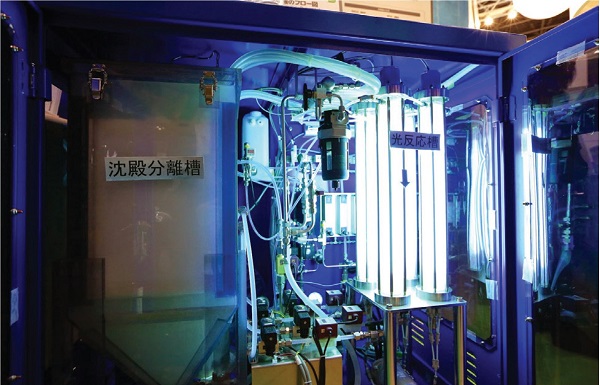
Water treatment using photocatalysis has gained prominence in recent years due to its efficiency in treating contaminated water. The technology utilises photocatalyst and ultraviolet(UV) rays to remove toxic substances from water. Panasonic developed a technology that binds the photocatalyst(titanium dioxide) to a commercial adsorbent and a catalyst called zeolite, ensuring effective separation and recovery of photocatalysts from the water for reuse. Titanium dioxide can mineralise a range of organic compounds into safe end products. The catalyst uses UV radiation either from sunlight or artificial light to separate substances.
Photocatalysis can break down a range of organic materials, estrogens, pesticides, dyes, crude oil, and microbes such as viruses and chlorine-resistant pathogens, as well as inorganic compounds such as nitrous oxides. Photocatalytic water treatment systems are suitable for use in water and wastewater treatment facilities and can treat industrial wastewater polluted with high loads of organic substances or metals.

아쿠아포린 인사이드 기술
Aquaporin Inside™ technology
덴마크 클린테크(근본적인 오염발생을 줄이는 환경기술) 회사인 아쿠아포린이 특허를 보유한 ‘아쿠아포린 인사이드(Aquaporin Inside™)’ 기술은 생체 모방 수처리 멤브레인 설계를 기반으로 한다. 아쿠아포린은 세포막을 통해 빠르고 선택적인 물 이동을 가능하게 하며, 이를 통해 세포는 정수압과 삼투압 차이에 따라 부피와 내부 삼투압을 조절할 수 있도록 한다.
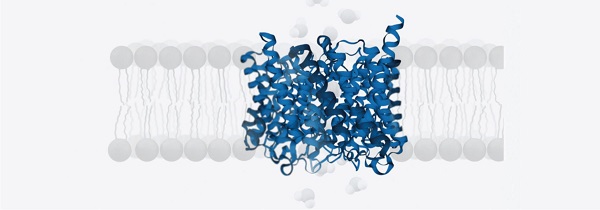
아쿠아포린만의 독특한 구조는 오직 물분자만 통과하도록 하고 다른 모든 화합물을 차단한다. 천연 생체 모방 멤브레인은 또한 인공 생체 모방 멤브레인 시스템 개발을 위한 기초가 되기도 한다. 이 기술은 산업과 가정의 정수 시스템에 사용되고 있다.
아쿠아포린 인사이드 멤브레인은 먹는물 정화를 위해 아쿠아포린(aquaporin, AQP)을 사용하는 시장 유일의 멤브레인으로, 정삼투(FO) 및 역삼투(RO) 응용 분야에 모두 사용이 가능하다. 아쿠아포린과 덴마크 항공회사(Danish Aerospace Company, DAS)의 합작 투자사인 아쿠아포린 스페이스 얼라이언스(Aquaporin Space Alliance, ASA)가 현재 아쿠아포린 인사이드 기술 상용화를 위해 유럽 및 미국 기반 회사와 협력하고 있다.
Aquaporin Inside™ technology from Danish cleantech company Aquaporin is based on the bio-mimetic water treatment membrane design. Aquaporins enable quick and highly selective water transfer across the cell membrane. They allow the cell to regularise its volume and internal osmotic pressure in line with the hydrostatic and osmotic pressure differences.
The aquaporin channel’s distinct architecture allows the passage of water molecules and blocks all other compounds. The natural bio-mimetic membranes also serve as a basis for the development of artificial bio-mimetic membrane systems. The technology is being used in industrial and household water filtration and purification systems.
The Aquaporin Inside membranes are the only membranes in the market to employ aquaporins to purify drinking water. The membranes are available for both forward osmosis(FO) and reverse osmosis(RO) applications. The Aquaporin Space Alliance(ASA), a joint venture between Aquaporin and Danish Aerospace Company(DAS) is commercialising the patented Aquaporin Inside™ technology in space applications and space programmes, in collaboration with European and US-based firms.
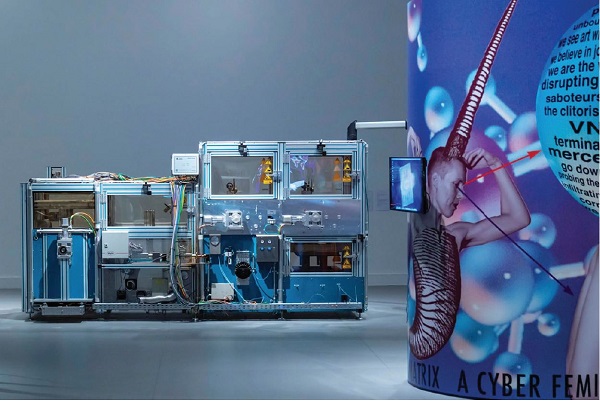
자동 가변 여과 기술
Automatic Variable Filtration(AVF) technology
자동 가변 여과 기술(Automatic Variable Filtration technology)은 유입수의 상향 흐름이 여과재(filter media)의 하향 흐름에 의해 정화되는 간단하면서도 최첨단 기술이다. 공정 자체에서 여과재는 유입수에 의해 세척되기 때문에 추가적인 공정이나 담수가 필요 없다. AVF 기술은 가변 어레이(array)에 내장된 연속 세척 하강 베드 필터(bed filter)를 사용한다. 시스템의 2단계 구성은 직렬 또는 병렬 모드로 작동이 가능한 두 세트의 미디어 필터(media filter)를 통합한다.
이 공정은 저압 멤브레인(low-pressure membrane)을 사용했을 때 소요되는 비용의 극히 일부만으로 미세여과(microfiltration) 기술과 동등한 품질의 물을 제공한다. AVF 시스템은 움직이는 부품이 없고 전력 소모가 적어 운영과 유지비용을 절감할 수 있다.
따라서 AVF 방법은 도시 상하수도 처리, 폐수 처리, 하·폐수 재이용을 비롯해 멤브레인 공정 및 담수화 응용 분야의 전처리여과(pre-filtration)에 적합하다. AVF 기술을 기반으로 한 제품과 서비스를 개발하는 주요 기업으로 R2O 워터 테크놀로지(R2O Water technologies), 프로세스 리서치 오르텍(Process Research ORTECH, PRO), 유레카 포브스(Eureka Fobes) 등이 있다.

Automated Variable Filtration(AVF) technology involves a simple process where upward flow of influent is cleaned by downward flow of filter media. It eliminates the need for any additional process or freshwater for filter media cleaning. The AVF method employs continuously cleaned descending bed filters embedded in a variable array.
The two-stage configuration of the system integrates two sets of media filters that can function either in serial or parallel mode. The process delivers water with quality equivalent to that of micro-filtration technology and at a fraction of the cost of low-pressure membranes.
It features no moving parts and consumes less power, offerings savings on reduced operating and maintenance costs. AVF systems are suitable for municipal drinking water and wastewater treatment, wastewater recycling and reuse, pre-filtration for membrane processes and desalination applications. R2O Water Technologies, Process Research ORTECH(PRO), and Eureka Forbes are some of the major companies involved in the development of AVF technology-based products and services.

[출처 = 워터테크놀로지(https://www.water-technology.net/features/latest-water-purification-technologies-top-five/) / 2021년 2월 5일]
[『워터저널』 2021년 3월호에 게재]

